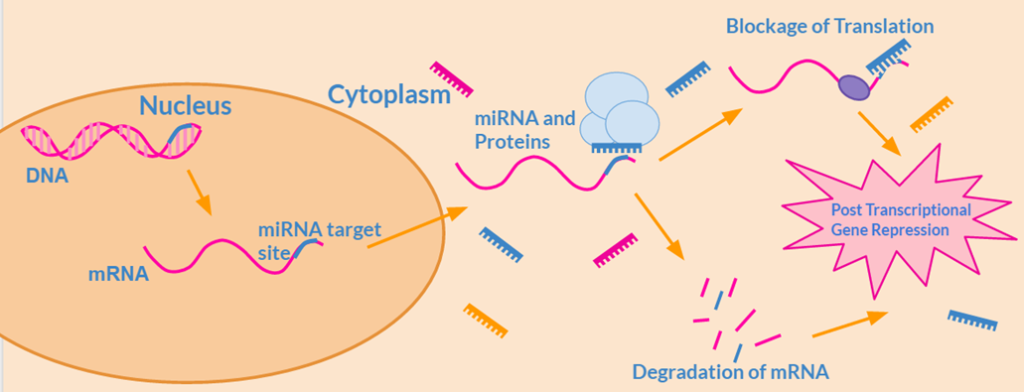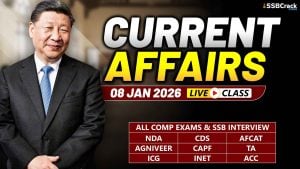Nobel Prize for Medicine this year has been awarded to Victor Ambros and Gary Ruvkun. According to the Nobel Prize website, the American scientists were honoured for “the discovery of microRNA and its role in post-transcriptional gene regulation”.
Nobel Prize For Medicine : MicroRNA Gene Regulation
Why In News
- Nobel Prize for Medicine this year has been awarded to Victor Ambros and Gary Ruvkun. According to the Nobel Prize website, the American scientists were honoured for “the discovery of microRNA and its role in post-transcriptional gene regulation”.
What Is microRNA
- MicroRNA are molecules that help cells control their protein production. The proteins that cells produce play vital roles in almost all biological processes of living organisms.
- In human bodies, for example, the protein haemoglobin transports oxygen, insulin helps absorption of glucose from blood, etc. Thus, anything that impacts protein production can have consequences for human health.
- MicroRNA works by binding with another type of molecule called messenger RNA (mRNA).
- “microRNA controls gene expression mainly by binding with messenger RNA (mRNA) in the cell cytoplasm. Instead of being translated quickly into a protein, the marked mRNA will be either destroyed and its components recycled, or it will be preserved and translated later.”
Why Did Ambros And Ruvkun Study microRNA
- Scientists were honoured for their “discovery of a fundamental principle governing how gene activity is regulated”. Here is an illustration to explain just what this means.
- Think of chromosomes, which carry genetic information in the form of DNA, as a large toolbox. Every cell in the body has the same toolbox, containing identical tools (or genes).
- But different cells need to use different tools depending on their job — while a nerve cell might grab a tool that helps send signals, a muscle cell might choose a different tool to enable movement.
- The key to these differences is gene regulation, a process that helps each cell pick the right tools for its specific tasks.
- In other words, only the appropriate set of genes is activated in each type of cell. Ambros and Ruvkun were curious about how gene regulation works.
- Their research led them to the discovery of microRNA, which provided a whole new way of understanding how bodies of complex organisms such as humans function.
How Was MicroRNA Discovered
- In the late 1980s, Ambros and Ruvkun were working under Nobel Prize-winning researcher Robert Horvitz, studying a tiny roundworm called C. elegans.
- Despite being just 1 millimetre long, this worm had many of the same cell types found in larger animals, making it an ideal candidate for understanding how tissues develop.
- Ambros and Ruvkun were particularly interested in two genes in these worms: lin-4 and lin-14.
- After setting up his lab at Harvard, Ambros began further investigating the lin-4 gene. To his surprise, he found that lin-4 produced a tiny RNA molecule that did not code for proteins like most genes do.
- Instead, this “micro” RNA simply blocked the activity of lin-14. Ruvkun, in his own lab, was closely examining the lin-14 gene when he discovered that lin-4 was not stopping the production of lin-14’s mRNA which carried genetic instructions for making its protein.
- This discovery revealed a fascinating new way in which genes could be controlled through tiny RNA molecules now called microRNAs. Initially published in 1993, the discovery got little notice as most scientists believed that this peculiar process was limited to C. elegans.
- everything changed in 2000 when Ruvkun’s team discovered another microRNA, called let-7, which was found across many species, including humans. This finding sparked widespread interest, leading to the identification of hundreds of microRNAs. microRNAs play a crucial role in gene regulation for nearly all multicellular organisms, including humans.
How Are People Selected For The Nobel Prize
- The first stage involves nominations. A range of people — university professors, former Nobel winners in that category, etc. — are deemed eligible by the respective Nobel Committee to submit a nomination for that award.
- The eligibility, and the larger process, slightly differ for all six awards. For example, heads of state and members of national assemblies and national governments can send nominations for the Peace Prize.
- Permanent professors in relevant subjects at the universities and colleges in Sweden, Denmark, Finland, Iceland and Norway can send nominations for the Economics Prize.
- A few institutions are responsible for awarding the Nobel Prizes: The Royal Swedish Academy of Sciences for the Nobel Prize in Physics and Chemistry, Sweden’s Karolinska Institutet for the Nobel Prize in Physiology or Medicine, the Swedish Academy for the Nobel Prize in Literature, a Committee of five persons elected by the Norwegian Parliament for the Nobel Peace Prize, and The Royal Swedish Academy of Sciences for the Economic Sciences prize.
























